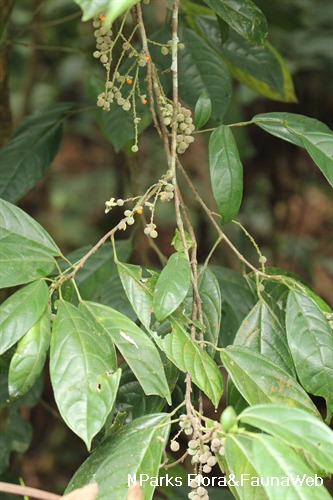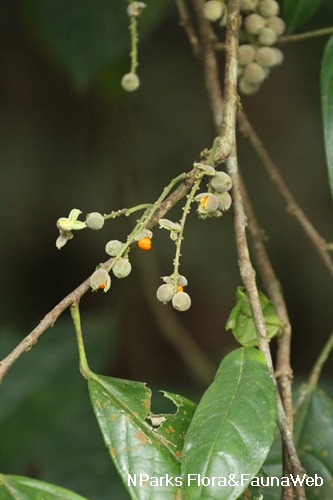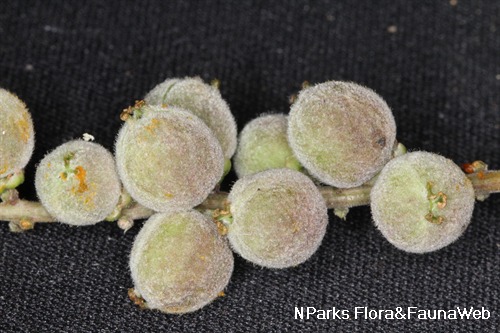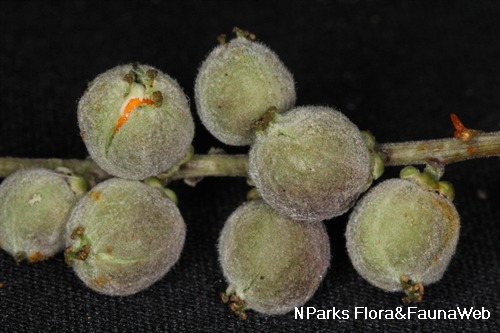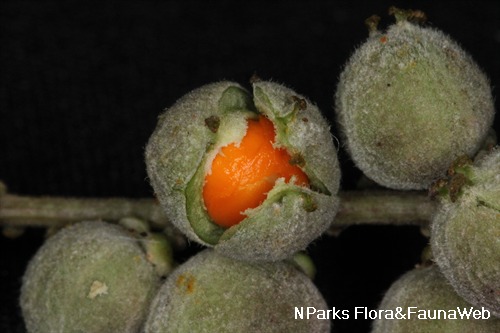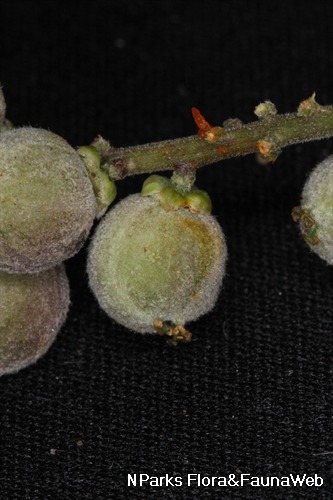.jpg)
Back
Osmelia grandistipulata Slooten
| Family Name: | Salicaceae |
| Synonyms: | Osmelia philippina auct. non (Turcz.) Benth. |
| Common Name: | Anang |
Osmelia grandistipulata is a Endangered tree native to Singapore, it can grow between 10 - 24 m tall. The leaves are glossy, short appressed hairs may only be found along the midrib and nerves on the underside. Male and female flowers are small, green to greenish-white borne on separate plants, on an inflorescence between 15 - 25 cm long. The fruit splits into 3, revealing its seed enclosed in a yellow, fleshy aril.
Name
Classifications and Characteristics
| Plant Division | Angiosperms (Flowering Seed Plants) (Dicotyledon) |
|---|---|
| Plant Growth Form | Tree (Medium (16m-30m)) |
| Lifespan (in Singapore) | Perennial |
| Mode of Nutrition | Autotrophic |
| Plant Shape | Irregular |
| Maximum Height | 24 m |
Biogeography
| Native Distribution | Borneo, Malaya, Sumatra, Singapore |
|---|---|
| Native Habitat | Terrestrial (Primary Rainforest, Freshwater Swamp Forest) |
| Preferred Climate Zone | Tropical |
| Local Conservation Status | Native to Singapore (Endangered (EN)) |
Description and Ethnobotany
| Growth Form | It is a tree that grows between 10 - 24 m, buttresses up to 60 cm tall. |
|---|---|
| Foliage | Leaves are oblong to ovate-elliptic shaped, tri-nerved from the base, glossy above, dull below measuring between 15 - 33 cm long by 5 - 10 cm wide. Short appressed hairs may be found along the midrib and nerves on the underside. |
| Flowers | The flowers are borne on an inflorescence between 15 - 25 cm long. The male and female flowers are small, white to greenish-white coloured, found on different plants. Both the flowering branches and flowers are covered short fine hairs. |
| Fruit | The fruit is an oblong to sub-globose capsule, green to greyish-purplish, covered in short rusty-coloured fine hairs measuring 0.8 - 1 cm long by 0.5 cm wide. Each fruit splits into 3 when mature, revealing the seed, usually single seeded, rarely 2, enclosed in a yellow, fleshy aril. |
| Habitat | Occur in forests, at low altitude rarely up to 600 m. |
| Taxonomy | Previous name of Osmelia philippina auct. non (Turcz.) Benth. was misused in Singapore. Current name of Osmelia grandistipulata Slooten is applicable to wild plants in Singapore but not necessarily to wild plants elsewhere or to cultivated plants originating elsewhere. |
| Cultivation | It can be propagated by seed. |
| Etymology | 'Osmelia' is Greek for the fragrance of honey, probably referring to the flower’s scent. |
| Ethnobotanical Uses | Timber & Products: The wood of Osmelia are mainly for local use such as house building, rough posts and manufacture of chairs. |
Landscaping Features
| Landscaping | It may be suitable for parks. |
|---|---|
| Landscape Uses | General, Parks & Gardens, Small Gardens |
Fauna, Pollination and Dispersal
| Pollination Method(s) | Biotic (Fauna) |
|---|---|
| Seed or Spore Dispersal | Biotic (Fauna) |
Plant Care and Propagation
| Light Preference | Full Sun, Semi-Shade |
|---|---|
| Water Preference | Moderate Water |
| Plant Growth Rate | Moderate |
| Rootzone Tolerance | Moist Soils, Well-Drained Soils |
| Propagation Method | Seed |
Foliar
| Foliage Retention | Evergreen |
|---|---|
| Mature Foliage Colour(s) | Green |
| Foliar Type | Simple / Unifoliate |
| Foliar Arrangement Along Stem | Spiral |
| Foliar Attachment to Stem | Petiolate |
| Foliar Shape(s) | Non-Palm Foliage (Oblong, Ovate, Elliptical) |
| Foliar Venation | Pinnate / Net |
| Foliar Margin | Entire |
| Foliar Apex - Tip | Acuminate |
| Foliar Base | Acute, Rounded / Obtuse |
Non - Foliar and Storage
| Stem Type & Modification | Woody |
|---|---|
| Root Type | Underground (Tap Root) |
Floral (Angiosperm)
| Flower & Plant Sexuality | Unisexual Flowers , Dioecious |
| Flower Colour(s) | Green, White |
|---|
| Flower Grouping | Cluster / Inflorescence |
| Flower Location | Terminal, Axillary |
| Flower Symmetry | Bilateral |
| Inflorescence Type | Panicle |
| Flowering Habit | Polycarpic |
Fruit, Seed and Spore
| Mature Fruit Colour(s) | Green, Purple, Silver / Grey |
|---|---|
| Mature Fruit Texture(s) | Velvety / Furry / Tomentose |
| Fruit Classification | Simple Fruit |
| Fruit Type | |
| Seed Quantity Per Fruit | Few (1-5) |
References
| References | Sleumer, H. (1954). Flacourtiaceae. Flora Malesiana, ser. I, 5(1), pp.1-106. Leiden: Naturalis Biodiversity Center. |
|---|
Image Repository
Others
| Master ID | 31207 |
|---|---|
| Species ID | 5601 |
| Flora Disclaimer | The information in this website has been compiled from reliable sources, such as reference works on medicinal plants. It is not a substitute for medical advice or treatment and NParks does not purport to provide any medical advice. Readers should always consult his/her physician before using or consuming a plant for medicinal purposes. |

.jpg)
.jpg)
.jpg)
.jpg)
